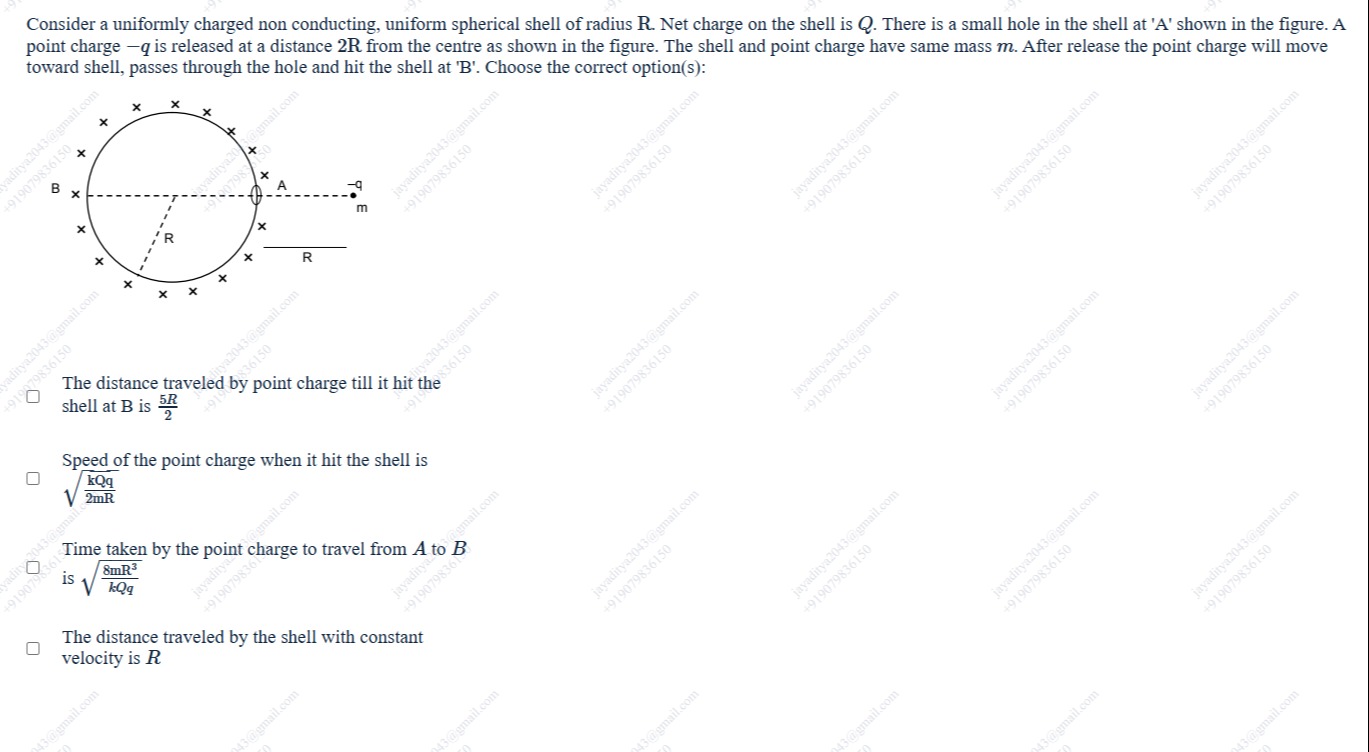Question
Question: Consider a uniformly charged non conducting, uniform spherical shell of radius R. Net charge on the ...
Consider a uniformly charged non conducting, uniform spherical shell of radius R. Net charge on the shell is Q. There is a small hole in the shell at 'A' shown in the figure. A point charge −q is released at a distance 2R from the centre as shown in the figure. The shell and point charge have same mass m. After release the point charge will move toward shell, passes through the hole and hit the shell at 'B'. Choose the correct option(s):

The distance traveled by point charge till it hit the shell at B is 25R
Speed of the point charge when it hit the shell is 2mRkQq
Time taken by the point charge to travel from A to B is kQq8mR3
The distance traveled by the shell with constant velocity is R
Speed of the point charge when it hit the shell is 2mRkQq
The distance traveled by the shell with constant velocity is R
Solution
We shall show that the only correct choices are (2) and (4).
Let the shell (mass m, charge Q) be free and its charge is fixed uniformly (except at a small hole). A point charge –q (mass m) is released from rest at 2R to the right of the shell’s center (O). (See the diagram below where “A” is the small hole at the right and “B” is the other (left‐side) point of impact.) Because the shell is nearly “complete” the force on the external point charge is the same as that due to a point charge Q placed at O. (Similarly the shell, by symmetry, feels the force as if all its charge were at its center.) Thus, for the external part of the motion the potential (per unit charge) is
V=kQ/r (when r ≥ R).
However, when the point charge enters the shell through the small hole A the interior field (for a complete spherical shell) is zero so that its speed remains constant thereafter. (The “hole” is taken small so that its effect may be neglected in the energy balance.)
A key step is to use conservation of the center–of–mass (COM) position. Initially, with the shell at O (x = 0) and the point charge at x = 2R, the COM is xcm=(0+2R)/2=R. Since there’s no external force the COM remains fixed.
Now we determine the “external” (accelerated) phase. Let the moment when the point charge reaches the hole A (a fixed point on the shell) be t = t_A. Since the hole belongs to the shell its position in the lab frame is xA=xs(tA)+R, where x_s(t_A) is the shell‐center. Also the point charge is exactly at A so x_p(t_A) = x_A. Conservation of COM gives (xs+xp)/2=R ⟹ (2xs+R)/2=R, so that xs(tA)=R/2 and xp(tA)=R/2+R=3R/2. Thus during the external phase the point charge goes from 2R to 3R/2 (a distance of 0.5R) while the shell’s center goes from 0 to R/2.
It is only during the external phase that work is done. The potential difference experienced by the point charge (or equivalently the two‐body system) when the “relative coordinate” (distance between point charge and shell–center) changes from ri=2R to rA=(xp–xs)=3R/2–R/2=R, is ΔU=−kQq(1/R−1/(2R))=−(kQq)/(2R). This lost potential energy goes into kinetic energy of both masses. Since they start from rest and have equal mass the energy is equally shared. Writing (½)m v^2 + (½)m v^2 = m v^2 = (kQq)/(2R), we obtain the speed (magnitude) acquired at A: v=2mRkQq. Once the point charge enters the shell (r < R), the interior potential is constant so its speed remains = √(kQq/(2mR)) until it “hits” the shell at point B. (Thus option (2) is correct.)
Now, at collision the point charge strikes the inner surface of the shell. In our lab frame, let the shell–center be at x = X and the collision occur at its leftmost point, so that the collision point is x = X – R. Conservation of COM requires (X+(X–R))/2=R ⟹ 2X–R=2R ⟹ X=3R/2. Thus the collision point is at x=3R/2–R=R/2. Notice that during the phase in which there is no force (inside the shell) the shell moves from x = R/2 (its position at A) to x = 3R/2, a displacement of R. (Thus option (4) is correct.) Also, during this inner phase the point charge moves from x = 3R/2 to x = R/2, a distance of R.
The remaining two choices can be checked:
- The total distance traveled by the point charge in the lab frame is 0.5R (from 2R to 3R/2 externally) plus R (from 3R/2 to R/2 internally) which gives 1.5R – not 5R/2.
- The time taken from A to B (inside the shell) is the (constant–velocity) time t = distance/speed = R/√(kQq/(2mR)) = √(2mR^3/(kQq)), not √(8mR^3/(kQq)).
Thus only options (2) and (4) are correct.
Explanation (minimal):
- Use the fact that outside the shell the field is as if all Q were at the center. Let the potential be V = kQ/r.
- Using COM conservation, at the hole A (a point on the shell) we obtain: shell center x = R/2 and charge x = 3R/2.
- Energy difference between r = 2R and r = R gives ΔU = –kQq/(2R) which is shared equally: m v² = kQq/(2R) → v = √(kQq/(2mR)). (Option 2)
- Once the charge is inside the shell, the field is (almost) zero so the velocities are constant. COM gives that the shell’s center moves an extra R. (Option 4)
Answer:
- Option (2) and Option (4) are correct.
